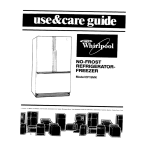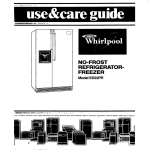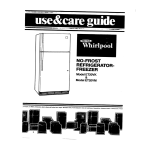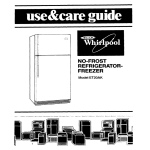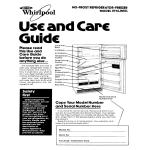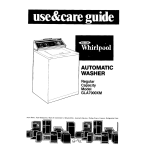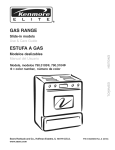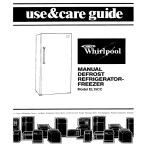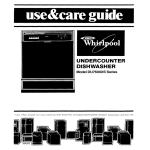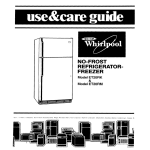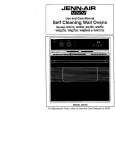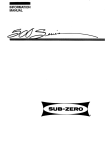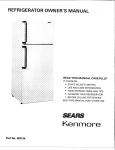Download Whirlpool EDI9SK User's Manual
Transcript
NO-FROST
REFRIGERATORFREEZER
Model EDISSK
ralor Fleecers
Ice Makers. Dishwashers
BullI-In Ovens and Surlace Un~ls. Ranges
MIcrowave
Ovens Trash COmpaclorS
Room Au Condlllaners
Dehumidlliers.
Aul~mal~c Washers
Clolhes Dryers
Freel
Please read this
Use and Care Guide
before you do anything else...
This booklet
tells you how to start your
refrigerator,
clean it, move shelves and adjust
controls.
It even tells you what new sounds to
expect from your refrigerator.
Treat your new refrigerator
with care. Use it
only to do what home refrigerators
are designed
to do.
Parts and features
I
TEMPERATURE
CONTROL
ICE CUBE
TRAYS
k
/
I
IH
v
UTILITY
COMPARTMENT
ADJUSTABLE
SHELVES
MEAT DRAWER
COVER
MEAT DRAWER
MODEL AND
SERIAL NUMBER
Y
fhank you for buying a Whirlpool
appliance.
Please complete
and mail the Owner Registratlon Card provided
with this product. Then complete
the form below. Have this informatlon ready
1 YOU need service or call with a question
,’- 4b
-.r
‘{ b,q, ),Jt
zno Serial Numbers from label
[see dlagran?
above)
and purchase
date
Yom sales slap
* Keep this bciok 2nd sales sltp together
In a
handy place?
Model
Number
Serial
Number
._-. .-
Purchase
Dote
Service Company
Phone Number
Contents
Page
SAFETY FIRST
BEFORE YOU PLUG IT IN
Install Properly
Level Refrigerator-Freezer
Remove Sales Labels..
:
Clean It
Plug It In
USING YOUR REFRIGERATOR.
Setting the Controls.
Changing
the Control Settings
Power Saving Control
Adjusting the Refrigerator Shelves
Removing the Freezer Shelves
Adjusting the Meat Drawer
Temperature
Removing Meat Drawer and
Cover........................
Removing the Freezer Trivet
Changing
the Light Bulb
Removing the Base Grille
Ice Cube Trays
Optional Automatic
Ice Maker
Sounds You May Hear
Energy Saving Tips
CLEANING YOUR REFRIGERATOR.
Cleaning
Chart
FOOD STORAGE GUIDE
Storing Fresh Food
Freezing and Storing Frozen Foods
VACATION AND MOVING CARE..
IF YOU NEED SERVICE OR ASSISTANCE.
WHIRLPOOL REFRIGERATOR
WARRANTY............................
6
6
7
7
7
7
8
8
8
9
10
10
11
14
15
16
6
(. 1988 Whirlpool
Corporation
Before you plug it in
Important
Betore using your refrigerator, you are personally
responsible
for making sure that it.
* IS Installed and leveled on a floor that will hold
the weight, and in an area suitable for its size
and use.
s IS connected
only to the right kind of outlet, with
the right electrical
supply
and grounding.
(Refer to your “Electrical
Requirements
and
Grounding
Instructions:‘)
0 15 used only for jobs expected
of home
refrigerators.
l
l
l
l
l
l
is not near an oven, radiator
or other heat
source.
is properly
maintained.
is out of the weather.
is used in an area where the room temperature
will not fall below 55-F (13C).
is not used by those who may not understand
how it should be used.
is not loaded with food before it has time to get
properly cold.
3
Remove sales labels...
Install properly...
Remove the Consumer
Buy Guide label, tape
and any inside
labels
before
using the refrigerator. To remove any remaining
glue:
1. Rub briskly with thumb to make a ball then
remove
OR
2. Soak area with liquid
hand dishwashing
detergent
before removing
glue as described
In step 1.
DO NOT USE rubbing alcohol or flammable
or
toxic solvents, such as acetone,
gasoline,
carbon tetrachloride,
etc. These can damage
the
material.
NOTE: DO NOT REMOVE ANY PERMANENT INSTRUCTIONS
LABELS INSIDE YOUR REFRIGERATOR.
Do not remove the Tech sheet fastened
under
the refrigerator
at the front.
Clean it...
Clean your refrigerator before using it.
See cleaning
instructions on page 8
1. Allow % inch (1.25 cm] space on each side and
at the top of the refrigerator
for ease of
installation.
2. If the refrigerator
is to be against a wall, you
might want to leave extra space so the door
can be opened wider.
3. The refrigerator
back can be flush agarnst the
wall.
Plug it in...
Level refrigerator-freezer..
.
3-PRONG GROUNDING
TYPE WALI . RECEPTACLE\
REFRIGERATOR
POWER CORD
RECOMMENDED
RAISE
1.
2.
3.
4.
5.
Remove base grille (see page 7).
To raise front, turn legs in direction shown
To lower front, turn legs in direction shown
Check with level.
Replace base grille [see page 7).
J-PRONG
GROUNDING PLUG
GROUNDING
METHOD
A 115 Volt, 60 Hz., AC only 15 or 20 ampere fused
and properly
grounded
electrical
supply
is
required. It is recommended
that a separate
circuit serving only this appliance
be provided.
Do not use an extension
cord. Use a receptacle which cannot be turned off with a switch or
pull chain. See individual
electrical
requirements
and grounding
instruction sheet in your literature
package
Using your refrigerator
TEMPERATURE CC
\
AIR CONTROL
Setting the controls...
AIR&LET
The Temperature Control is in the refrigerator and
the Air Control is in the freezer section. When the
refrigerator
is plugged
in for the first time...
1. Set the TEMPERATURE CONTROL to 3.
’
2
2. Set the AIR
CONTROLto3.,
1
POWER SAVING CONTROL
Give the refrigerator
time to cool down completely before adding
food. (This may take several hours.)
These settings should be about right for normal household
refrigerator
usage.
The controls will be set about right when milk or
juice is as cold as you like and when ice cream is
firm.
Do not block the air outlet on the control panel.
Blocking it can slow the air movement
needed to
keep temperatures
at the level you set.
5
Changing the control settings...
l
If you need to adjust temperatures
in refrrgeratol
or freezer, use the settings listed in the chart below
l
Adjust the Temperature
Control first.
Wait at least 24 hours between adjustments.
Then adjust the Air Control, if needed.
RECOMMENDED
CONTROL SETTINGS:
CONDITION:
REASON:
If Refrigerator
Section is
TOO WARM
Door opened often
Large amount of food added
Room temperature
too warm
Temperature
Air Control
Control
4
3
If Freezer
Section IS
TOO WARM
Door opened often
Large amount of food added
Very cold room temperature
[can’t cycle often enough)
Temperature
Air Control
Control
3
4
If Refrigerator
Section is
TOO COLD
Controls not set correctly
for your conditions
Temperature
Air Control
Control
2
3
If ICE isn’t
MADE FAST ENOUGH
Heavy ice usage
Very cold room temperature
(can’t cycle often enough]
Temperature
Air Control
Control
3
4
if BOTH SECTIONS
are TOO WARM
Door opened often
Large amount of food added
Very warm or very cold
room temperatures
Temperature
Air Control
Control
3
2
..L,
QUESTIONS?
call your
COOL-LINE’
service
assistance
telephone
number
l
[page151.
Power Saving Control...
The Power Saving Control on the Control Console oaerates
electric
heaters around the door
openings. These heaters help keep moisture from
forming on the outside of the refrigerator
OFF
I. Use the “OFF”
setting when
humrdity is low.
2. Use the “ON” setting
if moisture forms on
the outside of the
refrigerator.
I
Adjusting the refrigerator
Shelves can be adjusted
your refrigerator.
shelve
to match the way you
LlFl THE FRONT
THEN THE BACK
1. Lift front slightly.
2. Lift back off supports.
3. Replace in reverse order.
Removing freezer shelves.. .
1. Lift front slightly.
2. Lift back off supports.
3. Replace in reverse order.
Adjusting
LIFT THE FRONT
THEN THE BACK
meat drawer temperature...
Cold air flows against the meat drawer through
an opening
between
the freezer and the refrigerator. This helps keep the meat drawer colder
than the rest of the refrigerator.
Setthecontrol
to letmoreorlesscoldairthrough.
f
USE CONTROL TO ADJUST
MEAT DRAWER TEMPERATURES
Removing the meat drawer and cover...
To remove the meat
1. Slide meat drawer
2. Lift the front.
3. Slide the rest of the
4. Replace in reverse
drawer:
straight
out to the stop.
PUSH THE TAB
TO CLEAR THE COVER.
way out.
order.
To remove the cover:
l Cover
is held in place by two pegs at the back
and a notched tab in front.
1. Press front tab out of the way.
2. Lift cover front.
3. Lift back off the pegs.
4. Replace in reverse order.
Removing the freezer trivet.. .
1. Lift the trivet from the support
back wall.
2. Replace in reverse order.
brackets
on the
AAL. _.~
SNAP BACK INTO PLACE.
Changing the light bulb...
To change light bulb behind refrigerator
consoles:
1. Pull control knob straight off.
2. Pull bottom of control panel straight out.
3. Lift top of panel off supports.
4. Replace with a 40-watt appliance
bulb
5. Replace panel in reverse order.
PULL OFF THE DIAL;
PULL OUT AT THE BOTTOM
Removing the base grille...
To remove
the grille:
\
\
1. Open the doors.
2. Pull grille outwards as shown
3. Do not remove Tech sheet fastened
grille.
To replace
the grille:
1. Line up grille support tabs with metal
2. Push firmly to snap into place
3. Close the doors.
behlna
Ice cube trays...
To r emove ice:
1. Hold tray at both ends.
2. Slightly twist.
If cubes are not used, they may shnnk The movrng cold air starts a slow evaporation
The longer
cubes are stored, the smaller they get
Optional
automatic ice maker...
If you have the automatic
Ice maker accessory,
or If You plan to add one later (Part No. ECKMF-62).
there are a few things You will want to know
l
The ON/OFF lever is a wire signal arm
Downfor
making ice automatically
Up...to shut off the ice maker.
DO NOT TURN ICE MAKER ON UNTIL IT IS CONNECTED TO THE WATER SUPPLY.
LOWER
SIGNAL
clips
z
The dial or lever on the side of the Ice maker
changes the size of the cubes.
9 Shake the bin occasionally
to keep cubes separated, and to obtain increased storage capacity
l
l
It is normal
for
ir@
rroccenk
corner. They will break
tn
apart
ho
nitnrhad
hy
n
easily.
9 You will hear water running when ice maker is
working. You’ll hear ice fall into the bin. Don’t let
these sounds bother you.
l The Ice maker
will not operate
until the freezer
is cold enough
to make ice. This can take
overnight.
l Because
of new plumbing
connections,
the first
ice may be discolored
or off-flavored.
Discard
the first few batches of ice.
continued
on next page
l
l
l
If Ice is not being made fast enough and more
ice is needed, turn the Temperature
Control toward a higher number. Wait a day and, if necessary, turn the Air Control toward a higher number.
If you remove the ice bin, raise the signal arm to
shut off the ice maker. When you return the bin,
push it all the way in and lowerthe arm to the ON
position.
If cubes are stored too long, they may develop
an off-flavorrlike
stale water. Throw them away.
They will be replaced.
Cubes in the ice bin can
also become
smaller by evaporation
l
Good water quality
is important
for good ice
quality. It is not recommended
that the ice maker
be connected
to a softened water supply. Water
softener chemicals
such as salt from a malfunctioning
softener can damage
the ice maker
mold and lead to poor quality ice. If a softened
water supply cannot be avoided,then
it is important that the water softener be well maintained
and operating
properly.
Sounds you may hear...
‘5
=i
P
3’ \\
Possible
l
l
l
l
l
Sounds:
Your new refrigerator
may make sounds that your old one didn’t.
Because the sounds are new to you, you might be concerned
about them.
Don’t be, Most of the new sounds are normal. Hard surfaces like the floor,
walls and cabinets can make the sounds seem louder
The following chart describes
the kinds of sounds that might be new to
you, and what may be making them.
Probable
Causes:
Slight Hum, Soft Hiss:
You may hear the refrigerator’s
Clicking
Sounds:
The thermostat makes a definite click when the refrigerator stops running.
It also makes a sound when the refrigerator
starts. The defrost timer will
click when the defrost cycle starts and stops.
Water
or Snapping
fan motor and moving
air,
Sounds:
When the,refrigerator
stops running, you may hear gurgling in the tubing
for a few minutes after it stops. You may also hear defrost water running
into the defrost water pan.
Ice Maker Sounds:
-trickling
water
-thud
[clatter
of ice)
If your refrigerator
has an ice maker you may hear buzzing [from the
water valve], trickling water and the clatter of ice dumped
into the bin.
Running
Your refrigerator
has a high-efficiency
compressor
and motor. It will run
longer than older designs. It may even seem to run most of the time.
Sounds:
Energy saving tips...
You can help your refrigerator
use less electricity
. Check door gaskets for a tight seal. Level the
cabinet to be sure of a good seal.
. Clean the condenser
coil regularly.
. Open the door as few times as possible. Think
about what you need before you open the door
Get everything
out at one time. Keep foods organized so you won’t have to search for what you
want. Close door as soon as food is removed
l Go ahead
and fill up the refrigerator,
but don’t
overcrowd
it so air movement
is blocked
Cleaning your refrigerator
Both the refrigerator
and freezer sections defrost
automatically.
But both should be cleaned
about
once a month to help prevent odors from buildrng
up Of course,spills should be wiped up right away
To clean your refrigerator, turn the Temperature
Control to OFF, unplug it, take out all removable
parts, and clean it according
to the following
directions.
l
l
l
It is a waste of electricity
to set the refrigerator
and freezer to temperatures
colder than they
need to be. If ice cream is firm in the freezer and
drinks are as cold as your family likes them, that’s
cold enough.
Keep the Power Saving Control on OFF unless
moisture forms on the refrigerator
exterior.
Make sure your refrigerator
is not next to a heat
source such as a range, water heater, furnace,
radiator or in direct sunlight.
Cleaning chart...
How to clean
Part
What to use
Removable
parts
[shelves, crisper, meat
drawer, etc.)
Sponge or cloth, mild
detergent
and warm
water.
Outside
Sponge, cloth or paper
towel;mi\d
detergent.
appliance
wax
[or
good auto paste wax)
Waxing
Inside walls (Freezer
should be allowed to
warm up so cloth won’t
stick.)
painted
metal
Sponge,
soft cloth or
paper
towel,
baking
soda, warm water, mild
detergent
Wash removable
parts by hand
warm water and a mild detergent.
9 Rinse and dry.
Wash with warm
water
and a mild
detergent. Do not use abrasive
or harsh
cleansers.
l Rinse and
dry.
l Wax
painted
metal surfaces
at least
twice a year with appliance
wax or a
good auto paste wax. Apply wax with a
clean, soft cloth. Do not use wax on plastic parts.
surfaces provides
rust protection.
l
l
l
Door liners and gaskets
Floor under
Coil
refrigerator
Wash with warm water and
-mild detergent
or
- baking soda (2 tablespoons
1 quart [.95 L.] warm water).
Rinse and dry.
Wash with mild detergent
water.
l Rinse and
dry.
DO NOT USE Cleaning
waxes, concentrated
detergents,
or cleansers
containing
petroleum
on plastic parts.
Sponge or cloth; mild
detergent
and warm
water.
Defrost pan
Condenser
Sponge,
soft cloth or
paper
towel;
mild
detergent, warm water
Vacuum cleaner; using
the extended
narrow
attachment
Usual floor cleaners
with
l
l
[26 g] to
and
warm
bleaches
Remove base grille. (See page 7.)
To remove defrost pan, lift pan over wire
brace (remove tape; if any).
. Wash defrost pan with warm water and
mild detergent.
l Rinse and
dry.
l Replace
with notched corner to the rear.
Push it all the way in.
l Make
sure defrost drain tube is pointing
into pan
l Replace
base grille.
l
l
Remove base grille.
9 Clean dust and lint from condenser
least every other month.
l Replace
base grille.
l
l
l
l
l
at
Slide refrigerator
out only as far as water
Supply line allows.
Clean the floor.
Slide refrigerator
back into place.
Check to see if the refrigerator
is level.
Food storage guide
STORING
FRESH FOOD
Cured or Smoked Meat and Cold Cuts. Ham,
bacon, sausage, cold cuts, etc., keep best in original wrappings.
Once opened, tightly re-wrap in
plastic wrap or aluminum foil.
Canned
Ham. Store in refrigerator
unless the
label says it’s okay to store on the shelf. Do not
freeze.
Fresh Poultry...Wrap
in plastic wrap. The plastic
on poultry, as purchased,
may be used for storage.
I
STORAGECHART FOR FRESHAND CURED MEAT*
There is a right way to package
and store
refrigerated
or frozen foods. To keep foods fresher,
longer, take the time to study these recommended
steps.
leafy
Vegetables...Remove
store wrapping
and trim or tear off bruised and discolored
areas.
Wash in cold water and drain. Place in plastic bag
or plastic container and store in crisper. Cold, moist
air helps keep leafy vegetables
fresh and crisp.
Vegetables
with Skins (carrots, peppers]
..Store
in crisper, plastic bags or plastic container.
Fruit...Wash, let dry and store in refrigerator
In
plastic bags or crisper. Do not wash or hull berries
until they are ready to use. Sort and keep berries in
their store container
in a crisper, or store in a
loosely closed paper bag on a refrigerator
shelf
Meatf..Meat
is perishable
and expensive...you
won’t wantto waste an ounce of it through careless
handling.
The following
list and chart give you
packaging
hints and time limits. Store meat in the
meat drawer.
Fresh, Prepackaged
Meat. Store fresh meat In
the store wrapping.
Vacuum packaged
meat can
be frozen for as long as one month if the seal is not
broken. If you want to keep it frozen longer, you
should wrap it with special
freezer wrapping
material.
Fresh Meat, Not Prepackaged.
Remove the
market wrapping
paperand
re-wrap In aluminum
foil for storing it unfrozen.
Cooked Meat. Wrap or cover cooked meat with
plastic wrap or aluminum foil. Store immediately.
10
Time
Ways1
Variety Meats . . . . . . . . . . . . . . . . . . . . . . . lto2
Chlcken . . . . . . . . . . . . . . . . . . . . . . . . . . . . 1 to 2
1to2
Ground Beef . . . ..*..................
Steaks and Roasts . . . . . . . . . . . . . . . . . . 3 to 5
Cured Meats.. . . . . . . . . . . . . . . . . . . . . . . 7 to 10
5 to 7
Bacon .,............................
Cold Cuts . . . . . . . . . . . . . . . . . . . . . . . . . . . 3 to 5
TLPe
Approxlmate
‘If meat is to be stored longer than the times given,
follow the directions for freezing.
NOTE: Fresh fish and shellfish
same day as purchased.
should
be used the
Eggs...Store without washing in the original carton.
Milk...Wipe
milk cartons. For best storage, place
milk on interior shelf or bottom door shelf.
Beverages...Wipe
bottles and cans. Store on a
door shelf or inside the refrigerator.
Butter...Keep
opened butter in covered dish or
In the Utility Compartment.
When storing an extra
supply, wrap in freezer packaging
and freeze.
Cheese...Store
in the original
wrapping
until
you are ready to use it. Once opened,
re-wrap
tightly in plastic wrap or aluminum foil.
Condiments...Store
small jars and bottles
(catsup, mustard, jelly, olives] on the door shelves
where they are in easy reach.
Leftovers...Cover
leftovers with plastic wrap or
aluminum
foil to keep food from drying out and
transferring food odors. Plastic containers with tight
lids are fine, too.
F-REEZING & SI‘ORING
FROZEN FOODS
The freezer section is designed
for storage of
commercially
frozen foods and for freezing foods
,at home.
Packaging-The
secret of successful freezing IS
in the packaglng
The wrap you use must be air.
moisture and vapor proof. The way you close and
seal the package
must not allow air, moisture or
vaoor in or out Packaglng
done in any other way
could cause food odor and taste transfer throughout the refrigerator
and drying of frozen food
Rigid polyethylene
[plastic)
containers
with
tightfitting
lids, straight-sided
canning/freezing
jars. heavy-duty
aluminum foil, plastic-coated
paper and nonpermeable
plastic wraps (made from
a Saran film) are recommended.
NOTE: Heatsealed boiling bags are easy to use and can be
used by themselves
or as carton liners.
Sealing-When
sealing foods in bags squeeze
out the air (liquids need headspace
to allow for
expansion). Twist the top and turn it back. Fasten tie
securely
around the doubled-over
tall Put the
iabel inside transparent
bags; use self-adhesive
label on outside of opaque
ones
Ar-tightwrapping
calls for drugstore‘ wrap Cut
the sheet about one-third longerthan
the distance
around the food. Bring the ends together and fold
lr (toward the food) at least twice to seal out air
Creaseendsclosetofood.pressaIrfrom
oackage
Fold tips over twice. Finish package
and tape
closed NOTE: With unboned
meats, pad sharp
edges with extra wrap or use stockinette
to protect the wrap from punctures.
DO NOT USE:
Bread wrappers
l Non-polyethylene
plastic containers
9 Containers without tight lids
l Waxed
paper
l Waxed-coated
freezer wrap
l Thin, semi-permeable
wrap
None of these are totally moisture, air or vapor
proof. The use of these wrappings
could
cause food odor and taste transfer and drying of frozen food.
l
I
Freezing Fruits - Select ripe, blemish-free
fruits.
Be sure they taste as good as they look. Wash 2 to 3
quarts (liters) at a time and drain. Fruitthatstands
in
water may lose food value and become
soggy.
Sort, peel, trim, pit and slice as needed.
Pack in rigid wide-mouthed
containers or other
recommended
material.
Leave head space to
allow liquids to expand during freezing.
Freezing Vegetables
- Freeze only fresh highquality vegetables
picked when barely mature
For best results, freeze no more than 2 to 3 hours
after picking, Wash in cold water, sort and cut into
appropriate
sizes. Blanch or scald Pack in recom-mended conta,iner and freeze.
Do not freeze lettuce,
celery,
carrot
sticks,
potatoes or fresh tomatoes. All will become Imp or
mushy. Tomatoes will collapse
when thawed.
n
Freezing Meats - The meat you thaw can only
be as good as the meat you freeze. “Drugstore’
wrap in meal-size packages.
Flat cuts or patties
should be wrapped
individually
or in layers separated by a double thickness of freezer wrap.
Make sure store wrappings
are morsture and
vapor proof. If not, re-wrap meats with one of the
wraps recommended
under “Packaging”
Freezing Cooked Food-Prepare
cooked foods
as you would for the table; shorten cooking time10
to 15 minutes to allow for additional
cooking during reheating. Omit seasonings and part of the liquid. Plan to add them at reheating
time. Potatoes
should also be added to soup and stew at heating
time. Add crumb and cheese toppings at heating
time
Cool as rapidly as possible and freeze at once.
Liquid or semi-liquid
dishes may be frozen in recommended
containers
with head-space.
Casseroles and other more solid foods may be frozen
In the baking container. If you don’t want to leave
your casserole
dish in the freezer, line it with foil.
Bake, cool, freeze, lift out the foil package,
bag it
and return to freezer.
Freezing Baked GoodsWrap baked breads in
recommended
material.
Thaw in wrapping.
Unbaked yeast breads can be frozen aferthe
first
rising Punch down. wrap and freeze.
Bake cookies as usual. Cool and freeze on trays,
then pack in recommended
freezer bags or cartons. Unbaked cookies may be dropped,
molded
or rolled and frozen on cookie trays. Store in bag or
carton; bake without thawing.
Refrigerator-type
cookies can be wrapped
and frozen in roll form.
Thaw only enough to slice when ready to bake.
Fruit pies are best frozen unbaked. Bake without
thawing.
Bake pecan
and simrlar pies before
freezing...rrch
fillings do not freeze solid. Cut steam
vents in top crusts when ready to bake
Food
IMPORTANT: Do not expect yourfreezerto
quickfreeze any large quantity
of food. Put no more
unfrozen food into the freezer than will freeze
within 24 hours. (No more than 2 to 3 pounds of
food per cubic foot of freezer space.)
leave
enough space for air to circulate
around packages. Be careful to leave enough room at the
front so the door can close tightly.
FOOD STORAGECHART
Storage times* will vary according
to the qualiW’yof the food, the type of packaging
or wrap
used (moisture and vapor-proof),
and the storage temperature
which should be 0°F ( -17.8”C).
Storage lime
Food
FRUITS
........
12 months
Fruit juice concentrate
12 months
Commercially
frozen fruit .....
......
4 to 6 months
Citrus fruit and juices
8 to 12 months
Others ....................
VEGETABLES
..........
Commercially
frozen
8 months
8 to 12 months
Home frozen ..............
MEAT
4 weeks or less
Bacon ....................
Corned beef .............
4 weeks or less
(Salting meat shortens freezer life)
Frankfurters
.....................
1 month
Ground beef, lamb, veal ... 2 to 3 months
Roasts:
Beef ....................
6 to 12 months
lamb and veal ..........
6 to 9 months
4to8months
Pork .....................
1 to 2 months
Sausage,
fresh .............
Steaks and chops:
8 to 12 months
Beef ....................
3 to 4 months
lamb, veal, pork .........
FISH
Cod, flounder,
haddock
6 months
sole .........................
...........
2 to 3 months
Blue fish, salmon
...........
2 to 3 months
Mackerel,
perch
......
Breaded
fish (purchased)
3 months
Clams, oysters, cooked
.......
3 to 4 months
fish, crab, scallops
10 months
Alaskan
king crab ............
............
12months
Shrimp, uncooked
POULTRY
Chicken
or turkey,
..............
12months
whole or parts
6 months
Duck ..........................
Giblets
....................
2to3months
.......
6 months
Cooked
poultry w/gravy
................
1 month
Slices (no gravy)
MAIN DISHES
Stews; meat, poultry
.......
2 to 3 months
and fish casserole
.................
3 to 6 months
TV dinners
Storage
lime
DAIRY PRODUCTS
Butter ......................
6to9monfhs
.....................
12 months
Margarine
Cheese:
Camembert,
Mozzarella,
....................
3 months
farmer’s
DO NOT FREEZE
......
Creamed
cottage
Cheddar,
Edam, Gouda,
6 to 8 weeks
Swiss, brick, etc. ........
Freezing can change texture of
cheese.
2 months
Ice cream, ice milk, sherbet .....
EGGS
.................
12 months
Whole (mixed)
12 months
Whites .........................
12monfhs
Yolks.. .........................
(Add sugar or salt to yolks or whole mixed eggs)
BAKED GOODS
3 months
Yeast breads and rolls ..........
3 months
Baked Brown ‘N Serve rolls ......
................
Unbaked
breads
1 month
..............
2 to 3 months
Quick breads
2 to 4 months
Cakes, unfrosted
...........
............
Cakes, frosted
8 to 12 months
....................
12 months
Fruit cakes
3 months
Cookle dough ..................
............
Baked cookies
8 to 12 months
1 to 2 months
Baked pies .................
4 to 6 months
Ple dough only .............
*Based on U.S.D.A. and Michigan
Cooperative
Extension Service suggested storage times.
If electricity
goes off
Call the power company.
Ask how long power
will be off.
I. If service is to be interrupted
24 hours or IeSS,
keep both doors closed. This will help frozen
foods to stay frozen.
2. If service is to be interrupted
longer than 24
hours:
(a] Remove all frozen food and store in a
frozen food locker. Or...
[b) Place 2 Ibs (0.9 kg] of dry ice in freezer for
every cu. ft of freezer space. This will keep
frozen foods for 2 to 4 days. Wear gloves to
protect your hands from dry ice burns.
(c] If neither food locker storage nor dry ice is
available,
use or can perishable
food at
once
3. A full freezer will stay cold longer than a
partly filled cne. A freezer full of meat will stay
cold longer than a freezer full of baked
goods. If food contains ice crystals, it may
be Safely refrozen, although the quality and
flavor may be affected.
Use refrozen foods
quickly. If the condition of the food is poor or
If YOU feel it is unsafe, dispose of it,
Vacation
and
Short vacations...
Moving...
No need to shut off the refrigerator
if you WIII be
away for less than four weeks. Use up perishables,
freeze other items. If your refrigerator
is equipped
with an automatic
ice maker:
1. Turn it off
2. Shut off the water supply to the ice maker
3. Empty the ice bin.
If your refrigerator
IS equipped
with an automatlc Ice maker, shut off the ice maker water supply a day ahead of time. Disconnect the water line.
After the last supply of ice drops, lift the signal arm
to turn off the ice maker.
Remove all food. Pack frozen foods IF dry ice.
Unplug the refrigerator
and clean it thoroughly.
Remove everything
that comes out. Wrap all
parts well and tape them together so they don’t
shift and rattle.
Screw in the levelling rollers; tape the doors shut;
tape the electric cord to the cabinet. When you
get to your new home, put everything
back. and
refer to page 4. Don’t forget to reconnect the water
supply line if you have an ice maker
Long vacations...
Remove all the food if you are going for a month
or more. If your refrigerator
is equipped
with an
automatic
ice maker, turn off the water supply to
the ice maker at least a day ahead. When the last
load of ice drops, turn off the ice maker.
Unplug the refrigerator
and clean it...rinse well
and dry. Tape rubber or wood blocks to the top of
both doors...keeping
them open far enough for air
to get in. This will keep odor and mold from building up.
To restart
erator.”
14
refrigerator,
see “Using
Your Refrig
Questions?
...call your
COOL-LINE
service
assistance
telephone
number
[page 151.
If you need service or assistance,
we suggest you follow these five steps:
2. If you need assistance*...
1. Before calling for assistance...
Performance
problems
often result from lIttIe things
you can find and IIX yourself without tools of any kind
Call Whirlpool
phone number.
If your refrigerator
will not operate:
Is the electric
cord plugged
Into a live clrcult with
proper voltage?
(See page 4 )
l
Have you checked
your home’s main fuses or clrcult
oreaker
box?
l
Is the Temperature Control turned ON7
and talk with one of our trained Consultants.
The Consultants can instruct you in how to obtain satisfactory
operation
from your appliance
or, if service is necessary, recommend
a qualified
service company
in your
area
l
If there is a rattling
or jingling
noise or unfamiliar
sounds:
l Is something
on top or behind the refrigerator
maklng
noise when the refrigerator
IS running?
l
New features
on your new refngerator
make new
sounds. You may be hearing air flowing from the fans,
timer clicks for the defrosting
cycle. or defrost water
draining
in the defrost pan
If your ice maker will not operate:
Has the freezer had enough time to get cold’ With a
new refrigerator.
this might take overnlght
l
Is the slgnal arm ON .In the down posItIon
l Is the water
valve turned on? Is water getting to the ice
maker?
COOL-LINE’
service assistance
teleDial tree from anywhere
in the U.S.:
q-800-253-1301
If you need service?..
3.
Whirlpool
has a nationwide
network
01 -3 of franchised
TECH-CARE*
service
companies
TECH-CARE
service
12
1 technicians
are trained to fulfill the
i F~~H~~~4~~~
: product warranty
and provide afterwarranty
service, anywhere
in the United States. To locate TECH-CARE service in your area, call our COOLLINE service assistance
telephone
number (see Step 2)
or look in yourtelephone
directory
Yellow Pages under:
-%&I
l
If there is water in the detrost pan:
This IS normal in hot, muggy weather.
The pan can
even be half full. Make sure the refrigerator
IS level so
the pan does not overflow.
l
If the lights are not working:
0 Have you checked
your home’s main fuses or circuit
breaker?
l Is the power
supply cord plugged Into a live circuit with
:he proper voltage7 [See page 4)
Ii a bulb is burned out:
l See
Instructions
for changing
Only use appliance
bulbs
light bulbs
on page
6
If the motor seems to run too much:
l
I: the condenser
free of dust and lint?
0 On hot days, or If the room IS warm the motor naturally
runs longer
* It the door has been opened a lot, or if a large amount
of food has been put in, the motor will run longer to
cool down the interior
Remember:
Motor running time depends
on different
things, number
of door openings.
amount
of food
stored, temperature
of the room setting of the controls
And, your new refrigerator
may be larger than your
old one so it has more space to be cooled
It also has a
regular freezer instead of a frozen food compartment
Al! this means better refrigeration
and may require
inore running time than your old one
Call our COOL-LINE service
assistance
telephone
number (see Step 2) and talk with one of our Consultants, or if you prefer, write to
Mr. Robert Stanley
Division Vice President
Whirlpool Corporation
2000 M-63
Benton Harbor, Ml 49022
5. If you need FSP’
replacement parts?..
FSP- is a reglstered
trademark
of Whirlpool
Corporatlon for quality
parts. Look for this symbol
of quality
whenever
you need a replacement
part for your
Whirlpool
appliance.
FSP replacement
parts will fit
right and work right, because
they are made to the
same exacting
specifications
used to build every new
Whlrlpool
appliance.
To locate FSP replacement
parts in your area, refer to
Step 3 above or call the WhIrlpool
COOL-LINE service
assistance
number In Step 2.
*If
you must call or write, please
provide:
model
number, serial number, date of purchase, and a complete description
of the problem
This information
is
needed
in order to better respond to your request for
assistance
15
WHIRLPOOL”
REFRIGERATOR
WARRANTY
I FUP-TU
-s..-...
nF
-.
WADDAUTV
1.B..m1...
1
.
FULLONE-YEAR WARRANTY
WUIDI
. . . . .
_-.
Dnnl
---
WII
.-.--
I ..-..
DAV
RFOC
FnD
--
.
FSP” replacement
parts and repair labor to correct defects
in materials
or workmanship.
Service must be provided
by a
franchised
TECH-CARE’ service company.
From Date of Purchase
LIMITED FIVE-YEAR WARRANTY
FSP replacement
parts for electronic
control system if defective
in materials or workmanship.
[Electronic
models only.)
From Date of Purchase
FULLFIVE-YEAR WARRANTY
FSP replacement
parts and repair labor to correct defects in
materials
or workmanship
in the sealed refrigeration
system.
These parts are:
1. Compressor
2. Evaporator
3. Condenser
4. Drier
5. Connecting
tubing
Service must be provided
by a franchised
TECH-CARER service
company.
From Date of Purchase
WHIRLPOOL WILL NOT PAY FOR
A. Service
calls to:
1. Correct the installation
of the refrigerator.
2. Instruct you how to use the refrigerator.
3. Replace house fuses or correct house wiring or plumbing.
4. Replace
light bulbs.
B. Repairs when refrigerator
is used in other than normal, single-family
household
use.
C. Pick up and delivery. This product is designed
to be repaired
in the home.
D. Damage to refrigerator
caused by accident,
misuse, fire, flood, acts of God or use of
products not approved
by Whirlpool.
E. Any labor costs during limited warranty.
F. Any food loss due to product failure.
WHIRLPOOL CORPORATION SHALL NOT BE LIABLE FOR INCIDENTAL OR CONSEQUENTIAL DAMAGES. Some states
do not allow the exclusion
or limitation of incidental
or consequential
damages
so this limitation or exclusion
may not apply to you. This warranty
gives you specific
legal rights, and you may also have other rights which
vary from state to state.
Outside the United States, a different warranty
may apply. For details, please contact your franchised
Whirlpool
distributor
or military exchange.
Part No. 1114013Rev. A
c 1988 Whirlpool Corporation
Ice Makers
DIshwashers.
Bu~ll-In Ovens and Suriace Umls
Printed
Ranges
Microwave
Ovens Trash Compaclors
Room Air Condllloners.
Oehum!dllhers
Aulomalic
Washers
in U.S.A.
Clolncs Dryers
Freezers
Relrlge
















